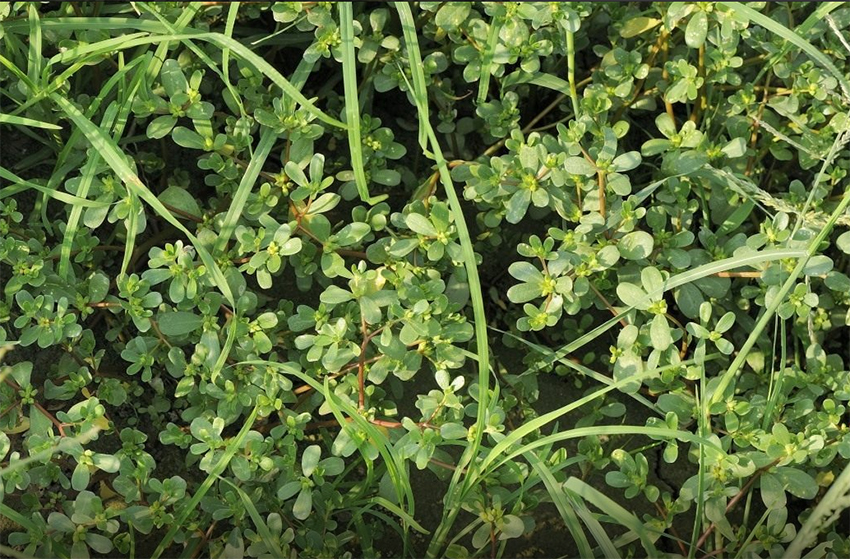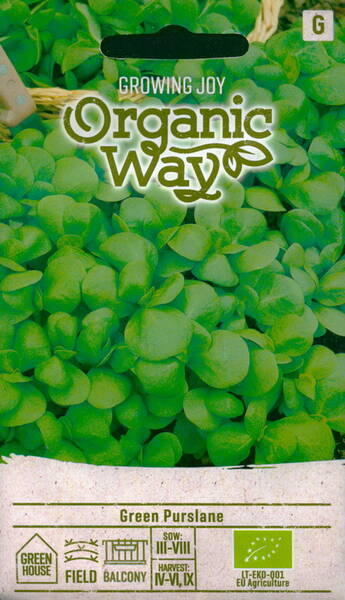Ex Tax: 1.10€
Healing multivitamin greens with a pleasant "sourness" and light-light pungency - an early alternative to spinach!
Annual early-ripening vegetable plant with juicy, fleshy stems and leaves.
Early maturing variety: 20-30 days from germination to technical maturity. It grows well on balconies and window sills.
A bed with this plant resembles thickets of dense, beautiful glossy greenery. Greens are rich in organic acids, contain carotene and vitamins. It is especially useful for people suffering from diabetes, liver and kidney diseases. Leaves and upper parts of young shoots are used for food in salads, as well as in soups and sauces. Pickled purslane is an excellent seasoning for meat dishes.
1.0 g = 2000 seeds.
Agrotechnics.
Sowing: May-June in well-warmed soil (open ground) or April for seedlings to a depth of no more than 0.5 cm. The distance between rows is 50-60 cm. In the phase of 1-2 true leaves, the plants are thinned out, keeping the distance between plants 10- 15 cm. The culture is thermophilic (does not tolerate even the slightest frost), prefers a sunny location and well-cultivated, fertile and moist soils. 20-30 days after sowing, the first cut is carried out (it is cut almost completely). Then the cut is repeated as needed, until the beginning of flowering. Usually 2-3 cuts are made during the growing season.

Eng.: Green Purslane, Green-Leaved Purslane, Kitchen-Garden Purslane.
* Purslane has been known since antiquity. From Egypt, Italy, Greece came to other countries of southern Europe. It is loved in the south, and to the north it began to spread with the advent of inexpensive covering material.
Small round-oval thickened leaves, juicy and crispy, slightly sour, good for fresh salads, they are nice to just chew in the heat. Fleshy (up to 1.5 cm) shoots are stewed, marinated, salted and served as a side dish for meat.
The leaves are green, sometimes with an anthocyanin edging, the same shade is found in a creeping stem that branches from the base, which is why the purslane sown in rows quickly forms a continuous mat about 20 cm high on the garden bed. The flowers are yellow.
Small dark gray or black seeds are sown to a depth of 0.5-1 cm with a distance between rows of 40-50 cm in warm (+12+15°C) soil; germinate in 10-14 days. The leaves usually begin to tear after two weeks - simultaneously with the thinning of the plants by 10-15 cm. The shoots cut off in the summer at a height of 3-4 cm from the ground grow back in two to three weeks.
This culture does not tolerate waterlogging of roots and tops, and any soil suits it, but more powerful bushes with large leaves develop on fertile and loose ones. Purslane is often used as a sealant, for example, for cabbage, tomatoes.
Young leaves and stems of purslane have a pleasant aroma and a slightly pungent, sour taste that gives a feeling of freshness. Green purslane quenches thirst, stimulates appetite, increases vitality.
Purslane juice is recommended for diseases of the liver, kidneys, bladder. It is prescribed as an anti-inflammatory and diuretic, with mild forms of diabetes mellitus (lowers blood sugar levels and promotes the formation of insulin in the body).
Freshly squeezed juice is indicated for scurvy and dysentery, as a diuretic, antitoxic, wound healing agent, for impotence (as part of a mixture), trichomonas colpitis, internal bleeding. Assign up to 100-150 ml of juice per day with a spoonful of honey before meals. Outwardly, it is prescribed to relieve swelling and inflammation in the bites of poisonous snakes and insects, in the form of compresses for abscesses, boils, burns, wounds. Contraindicated in hypertension. Purslane cultivars also have medicinal properties, but to a lesser extent.
* Canned purslane.
Washed shoots are cut into lengths of 5-8 cm, blanched in water (+90+100°C) for 3-5 minutes and put on a sieve or colander. At the bottom of half-liter jars, put 1 bay leaf and 1-2 cloves of garlic, cut into pieces, then lay blanched purslane shoots and pour brine (500 ml of water, 10-15 g of salt and vinegar essence). Banks are pasteurized in boiling water for 20 minutes, after which they are rolled up.












